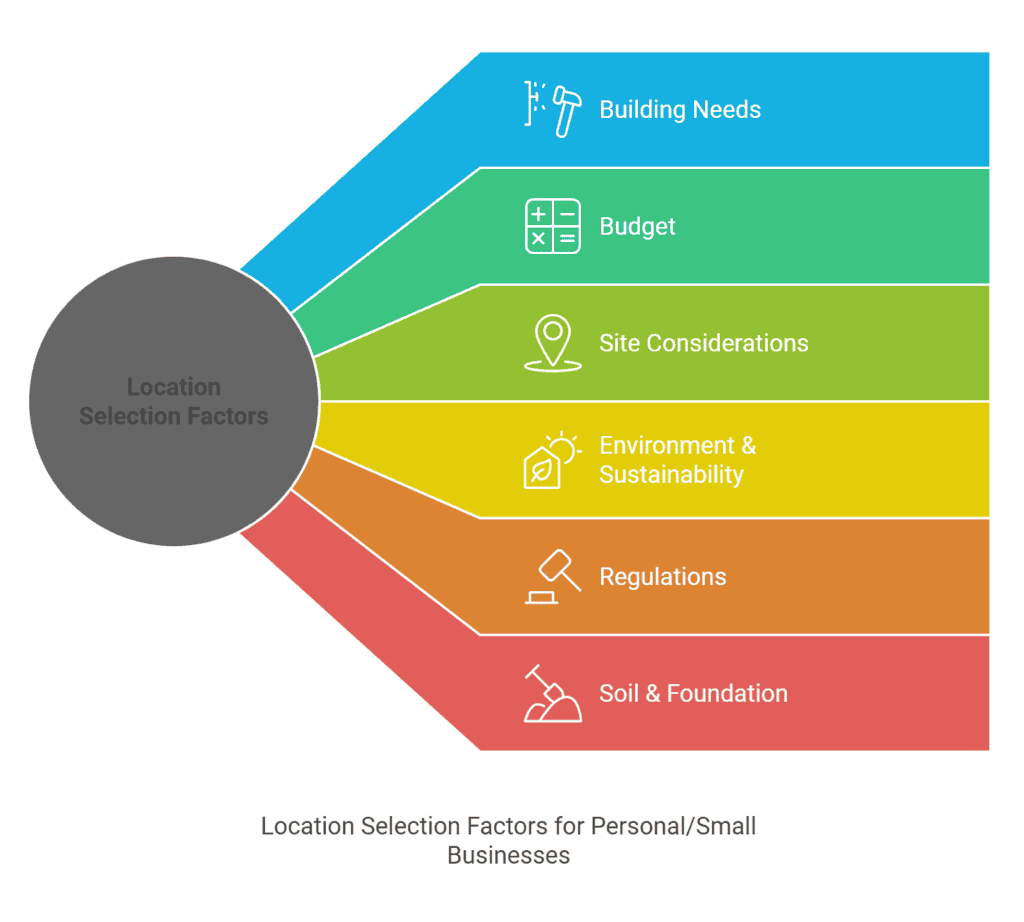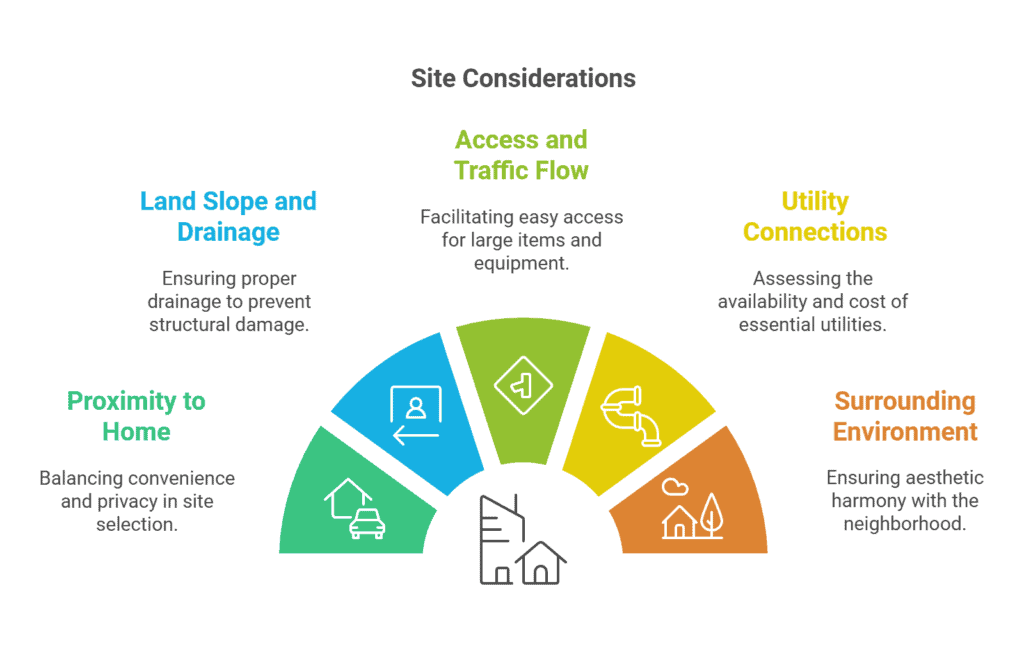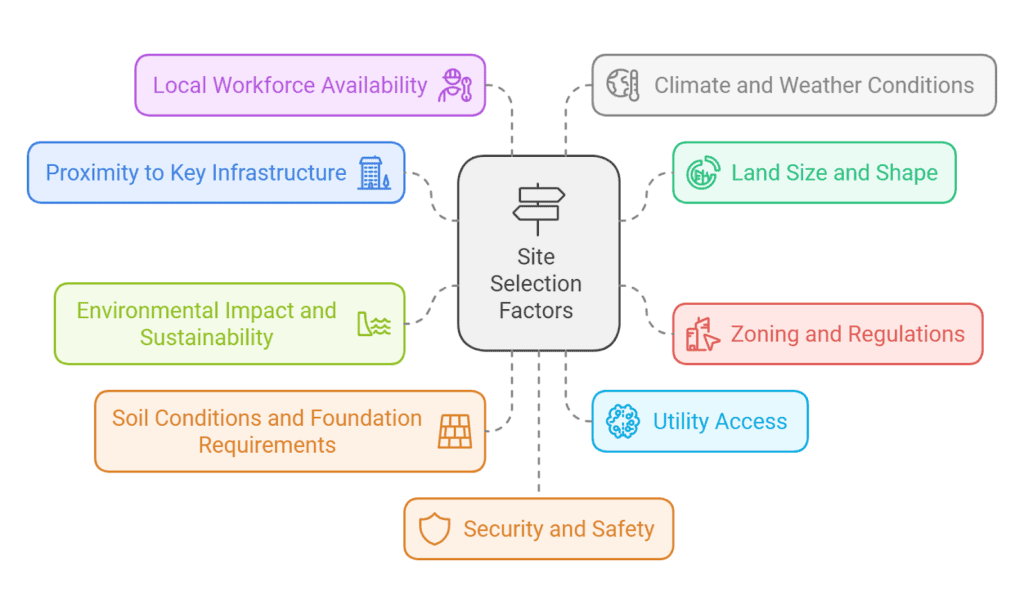Choosing the right location for your metal building can feel like a daunting task, but it’s one of the most important decisions you’ll make. Did you know that the Construction Industry Institute (CII) once reported that around 30%-50% of construction delays are caused by site-related issues, such as poor drainage or zoning problems? Whether you’re planning a personal workshop, a small business garage, or a large commercial facility, the site you choose will directly impact your building’s functionality, cost, and longevity. The question is, how do you find the perfect site without making costly mistakes?
In this blog article, we’ll walk you through everything you need to know to choose the best site for your metal building, whether you are a personal user/small business owner or a medium to large business owner.
Here’s what we’ll cover:
By the end of this article, you’ll understand the key factors to consider—ranging from budget and land slope to zoning laws and environmental impact. You’ll learn how to evaluate potential sites, avoid common pitfalls, and set your project up for success—ensuring that your metal building will serve you well for years to come.
So let’s not waste more time and dive straight into the factors you should consider to choose the right location for your metal buildings!
Part 1: Location Selection Tips for Personal Users and Small Business Owners

Pre-Planning for Your Metal Building Site
1. Understand Your Building Needs
Start by defining what you’ll use the building for. Whether it’s a garage, workshop, storage space, or tool shed, knowing this helps narrow down your location options.
2. Set a Realistic Budget
Calculate your budget early. Include costs for the building, foundation, and any utilities. Factor in potential unexpected expenses. Stick to your budget to avoid surprises later.
Key Factors to Consider When Choosing Your Site

1. Proximity to Your Home
If it’s for personal use, like a garage or workshop, consider how close the building should be to your house. You want convenience, but not at the cost of your home’s curb appeal. Aim for a balance between easy access and privacy.
2. Land Slope and Drainage
Avoid sites where water might collect around your building. Poor drainage can damage the structure over time. Look for land that slopes away from the building area or invest in proper drainage solutions to prevent water buildup.
3. Access and Traffic Flow
If you plan to store large items or use the building as a workspace, you’ll need easy access. Ensure that roads leading to your site are wide enough and in good condition for vehicles, especially if you have large equipment.
4. Utility Connections
Check the availability of essential utilities such as electricity, water, and sewage at your chosen location. The cost and feasibility of connecting these utilities can vary significantly depending on the site, so it’s important to factor this in before making a decision.
5. Surrounding Environment and Aesthetic Considerations
The exterior design of your building should blend well with the surrounding environment. Be mindful of how the building’s appearance may impact the aesthetic of your property or the neighborhood.
Sustainability and Environmental Adaptability
1. Climate Considerations
Pay attention to the local weather. If you’re in an area with heavy snowfall or high winds, your building needs to be designed to withstand those conditions. In warmer areas, consider heat resistance and ventilation.
2. Directional Exposure and Building Orientation
When choosing a location for your metal building, consider its orientation. A well-planned orientation can enhance natural light usage and help reduce energy costs. For instance, buildings facing south can take full advantage of solar power, while those facing north can avoid excessive sun exposure. Proper directional exposure improves energy efficiency and internal comfort.
3. Eco-Friendly Site Selection
Think about the environment. Choose a location that doesn’t disturb local wildlife or natural resources. Look for ways to take advantage of natural energy like sunlight (for solar panels) or rainwater collection systems to reduce your carbon footprint and long-term operating costs.
Regulations and Permits
Know Local Zoning and Codes
Every area has its own rules about where and how buildings can be placed. Check with local authorities to make sure your site meets all zoning laws and building codes. Failing to do so could result in costly delays or fines.
Soil and Foundation Considerations
1. Soil Test
The soil condition will affect the foundation. Get a simple soil test to ensure the land can support your building. You may need to choose a different foundation type depending on soil quality.
2. Foundation Requirements
A solid foundation is essential for the durability of your building. Whether you go with a concrete slab or another type of foundation, make sure it’s done right. If you’re not sure, consider hiring a professional to help with the foundation setup.
Key Takeaways
When selecting a site for your metal building, start by understanding its purpose and setting a realistic budget. Choose a location that balances convenience with privacy, and ensures good drainage and access. Make sure utilities are available, and consider the building’s aesthetic impact on your property and the neighborhood. Factor in climate conditions, such as temperature extremes or heavy winds, and orient your building for energy efficiency. Finally, check local zoning laws and perform a soil test to ensure the site is suitable for the foundation you need.
Part 2: Location Selection Tips for Medium to Large Business Owners
Pre-Planning for Your Metal Building Site
1. Define Your Business Needs
Start by clearly identifying your business requirements. Are you building a warehouse, manufacturing facility, or office space? Understand your space, storage, and operational needs. This will help you determine the size, layout, and location criteria for your building.
2. Long-Term Growth and Expansion
Consider your future needs. Will your business grow or require more space in the coming years? Choosing a site with room for expansion can save you time and money later. Avoid sites that limit growth potential or require complex modifications down the road.
3. Budget and Financial Considerations
Determine your budget early on, considering not just construction costs but long-term operational expenses. Factor in land purchase, site preparation, utilities, and infrastructure. Evaluate the cost-effectiveness of your chosen location based on its potential for future growth and long-term efficiency.
Key Factors to Consider When Choosing Your Site

1. Proximity to Key Infrastructure
For businesses, location is everything. Choose a site with easy access to highways, major roads, and transportation hubs like ports or airports. Good transportation links are crucial for efficient supply chains, logistics, and employee access.
2. Land Size and Shape
The size and shape of the land are critical. Make sure the land is large enough to accommodate the building and any future expansions. Irregularly shaped lots may limit your building options, so opt for rectangular or square plots where possible.
3. Zoning and Regulations
Local zoning laws and building codes can significantly impact your project. Ensure that the land is zoned for industrial or commercial use, depending on your needs. Check for any specific regulations related to construction, utilities, or environmental impact.
4. Environmental Impact and Sustainability
Sustainability is increasingly important. Choose a location that minimizes environmental impact. Look for areas that support green initiatives such as solar panel installation, water conservation, or waste management systems. Consider how your business can align with local environmental policies or green certifications like LEED.
5. Soil Conditions and Foundation Requirements
The soil type and condition will influence the foundation of your building. Conduct a thorough soil test to understand its load-bearing capacity. A poor foundation can lead to costly repairs down the line. Choose a site with solid, stable soil to minimize risk and ensure long-term stability.
6. Utility Access
Access to utilities like electricity, water, gas, and telecommunications is crucial for business operations. Consider the availability and cost of connecting to these utilities. Businesses in rural or undeveloped areas may face higher infrastructure costs. Plan ahead to avoid delays.
7. Local Workforce Availability
A strong local workforce is key for operational efficiency. Choose a location where skilled labor is readily available. Also, consider employee commuting times and transportation options to ensure you attract and retain talent.
8. Climate and Weather Conditions
Consider the climate and weather risks in your area. Extreme weather, like high winds or heavy snow, can impact your building design and operational efficiency. Choose a location where your building and business can withstand local weather conditions. For example, consider stronger foundations or insulation if you’re in a region with extreme temperatures.
9. Security and Safety
Security is critical for businesses, particularly those storing inventory, equipment, or sensitive materials. Choose a site in a low-crime area and ensure it’s accessible for emergency responders. Adequate lighting, fencing, and surveillance systems are essential to protect your investment.
Regulatory and Legal Considerations
1. Permits and Approvals
Securing permits and approvals can be time-consuming, but it’s essential to avoid delays. Ensure that the site you’re considering meets all local regulations, including building codes, environmental guidelines, and safety standards. Work closely with local authorities to streamline the approval process.
2. Tax Incentives and Government Policies
Some regions offer tax incentives, grants, or subsidies for businesses that invest in certain areas. Research these opportunities to lower your operating costs and improve your return on investment. A good location can offer significant financial benefits, especially if it’s located in an area with business-friendly policies.
Site Selection and Technological Considerations
1. Advanced Site Selection Tools
Consider using GIS (Geographic Information Systems) or 3D modeling tools for precise site analysis. These technologies can help identify optimal sites, assess land use patterns, and evaluate transportation options. Technology can streamline the decision-making process and reduce risks.
2. Smart Infrastructure and Connectivity
As businesses become more dependent on technology, location choice should also consider smart infrastructure. Does the area have high-speed internet, reliable telecommunication networks, or even IoT-enabled systems for better efficiency? Choose a site where connectivity is strong, supporting your business’s technological needs.
3. Disaster Preparedness
Think about potential natural disasters like floods, earthquakes, or hurricanes. Ensure that the site is not prone to such risks or that the necessary measures (e.g., building elevation or seismic reinforcement) can be implemented. Being proactive about disaster preparedness can prevent costly damage in the future.
Key Takeaways
When selecting a location for your metal building, it’s crucial to focus on both immediate needs and long-term growth. Start by defining your business’s space, operational, and storage requirements while also planning for future expansion. Budget early, considering not just construction costs but also long-term expenses related to land, utilities, and infrastructure.
Key factors to prioritize include proximity to key infrastructure like highways and transportation hubs, access to utilities, and the size and shape of the land. Ensure the land is zoned appropriately and accommodates your business’s future needs. Don’t overlook environmental impact—sustainability is important, so choose a site that supports green initiatives.
Thoroughly assess the soil condition to ensure a stable foundation, and make sure your location has a skilled local workforce. Consider your area’s climate and weather conditions and plan your building’s design accordingly to withstand extreme weather. Finally, ensure the location has adequate security measures, including lighting, surveillance, and emergency accessibility.
Remember to navigate through regulatory requirements and take advantage of tax incentives or government policies that may benefit your business. Leveraging technology like GIS and 3D modeling can help streamline the site selection process while considering smart infrastructure and disaster preparedness will safeguard your investment in the long run.

